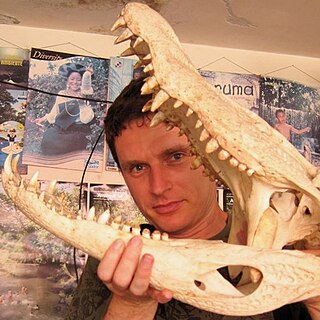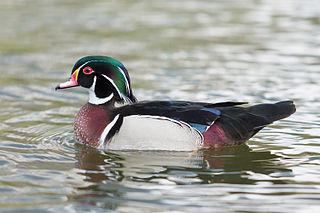
Ecology is the study of the relationships between living organisms, including humans, and their physical environment. Ecology considers organisms at the individual, population, community, ecosystem, and biosphere level. Ecology overlaps with the closely related sciences of biogeography, evolutionary biology, genetics, ethology, and natural history. Ecology is a branch of biology, and it is not synonymous with environmentalism.

Jared Mason Diamond is an American geographer, historian, ornithologist, and author best known for his popular science books The Third Chimpanzee (1991); Guns, Germs, and Steel ; Collapse (2005), The World Until Yesterday (2012), and Upheaval (2019). Originally trained in biochemistry and physiology, Diamond is known for drawing from a variety of fields, including anthropology, ecology, geography, and evolutionary biology. He is a professor of geography at UCLA.

Herpetology is the branch of zoology concerned with the study of amphibians and reptiles. Birds, which are cladistically included within Reptilia, are traditionally excluded here; the scientific study of birds is the subject of ornithology.

Marmots are large ground squirrels in the genus Marmota, with 15 species living in Asia, Europe, and North America. These herbivores are active during the summer, when they can often be found in groups, but are not seen during the winter, when they hibernate underground. They are the heaviest members of the squirrel family.

The flight zone of an animal is the area surrounding an animal that if encroached upon by a potential predator or threat, including humans, will cause alarm and escape behavior. The flight zone is determined by the animal's flight distance, sometimes called flight initiation distance (FID) which extends horizontally from the animal and sometimes vertically. It may also be termed escape distance, alert distance, flush distance, and escape flight distance.

The Olympic marmot is a rodent in the squirrel family, Sciuridae; it occurs only in the U.S. state of Washington, on the middle elevations of the Olympic Peninsula. The closest relatives of this species are the hoary marmot and the Vancouver Island marmot. In 2009, it was declared the official endemic mammal of Washington.

The Rocky Mountain Biological Laboratory is a high-altitude biological field station located near Crested Butte, in the abandoned mining town of Gothic, Colorado in the West Elk Mountains. The laboratory was founded in 1928. Research areas include the ecology of the region, climate change, pollination biology, and a long-running study of the yellow-bellied marmot. The laboratory offers courses for undergraduate students, including National Science Foundation-funded REU students, and provides support for researchers from universities and colleges.
Lee Hannah is a conservation ecologist and a Senior Researcher in Climate Change Biology at Conservation International. Hannah is one of many authors who published an article predicting that between 15% and 37% of species are at risk of extinction due to climate change caused by human greenhouse gas emissions.
Modern environmental education in the United States began to take shape in the late 19th century with the Nature Study movement, which grew out of efforts to promote the field of natural history by naturalists including Harvard professor Louis Agassiz (1807-1873) and Anna Botsford Comstock, whose Handbook of Nature Study was published in 1911.

Marc Bekoff is an American biologist, ethologist, behavioural ecologist and writer. He was a professor of Ecology and Evolutionary Biology at the University of Colorado Boulder for 32 years. He cofounded the Jane Goodall Institute of Ethologists for the Ethical Treatment of Animals, and he is Professor Emeritus of Ecology and Evolutionary Biology at the University of Colorado Boulder.

Valerius Geist was a Canadian biologist and a professor emeritus in the Faculty of Environmental Design at the University of Calgary. He was a specialist on the biology, behavior, and social dynamics of North American large mammals, and well respected on his views of Neanderthal people and behavior.
Catherine L. Malone is an American biologist and an author and co-author of biological subjects including works on biogeography and genetic variation.

Vladimir Dinets is a Russian zoologist and author, known for his studies of Crocodilian behavior and of numerous rare animals in remote parts of the world, as well as for popular writings in Russian and English.

Conservation behavior is the interdisciplinary field about how animal behavior can assist in the conservation of biodiversity. It encompasses proximate and ultimate causes of behavior and incorporates disciplines including genetics, physiology, behavioral ecology, and evolution.

Steven J. Cooke is a Canadian biologist specializing in ecology and conservation physiology of fish. He is best known for his integrative work on fish physiology, behaviour, ecology, and human-dimensions to understand and solve complex environmental problems. He currently is a Canada Research Professor in Environmental Science and Biology at Carleton University and the Editor-in-Chief of the scientific journal Conservation Physiology.

Scott P. Carroll is an American evolutionary biologist and ecologist affiliated with the University of California, Davis and the University of Queensland. Carroll's main interests are in exploring contemporary evolution to better understand adaptive processes and how those processes can be harnessed to develop solutions to evolutionary challenges in food production, medical care and environmental conservation. With Charles W. Fox, Carroll edited Conservation Biology: Evolution in Action, a book published by Oxford University Press in 2008 in which contributors, across the field of evolutionary biology and conservation, apply evolutionary thinking to concepts and practices in conservation biology, an area of research sometimes called evolutionary ecology. Carroll is founding director of the Institute for Contemporary Evolution.

Leslie Jane Rissler is an American biologist best known for her work on amphibian and reptile biogeography, evolutionary ecology, systematics, and conservation, and for her strong advocacy of improving the public’s understanding and appreciation of evolution. She is currently Program Officer in the Evolutionary Processes Cluster of the Division of Environmental Biology and Directorate of Biological Sciences at the National Science Foundation.

Robert Cyril Stebbins was an American herpetologist and illustrator known for his field guides and popular books as well as his studies of reptiles and amphibians. His Field Guide to Western Reptiles and Amphibians, first published in 1966, is still considered the definitive reference of its kind, owing to both the quality of the illustrations and the comprehensiveness of the text. A professor of zoology at the University of California, Berkeley, for over 30 years, he was the first curator of herpetology at the Museum of Vertebrate Zoology, a 1949 Guggenheim fellow, and author of over 70 scientific articles. His discovery of the ring species phenomenon in Ensatina salamanders is now a textbook example of speciation, and he performed extensive research on the parietal eye of reptiles. He produced nature films, supported science education in primary grades, and organized conservation efforts that aided in the passing of the 1994 California Desert Protection Act. After retirement he continued to paint, collect field notes, and write books. Stebbins is commemorated in the scientific names of three species: Batrachoseps stebbinsi, the Tehachapi slender salamander; Anniella stebbinsi, a legless lizard; and Ambystoma tigrinum stebbinsi, the endangered Sonora tiger salamander.

Jennifer Elaine Smith is a behavioral ecologist and evolutionary biologist. She is an Assistant Professor of Biology at University of Wisconsin, Eau Claire. Previously, she was an Associate Professor and Chair of Biology at Mills College, in Oakland, California, prior to its merger with Northeastern University. Her research focuses primarily on the social lives of mammals based on insights gained from long-term studies on marked individuals and comparative approaches.
















